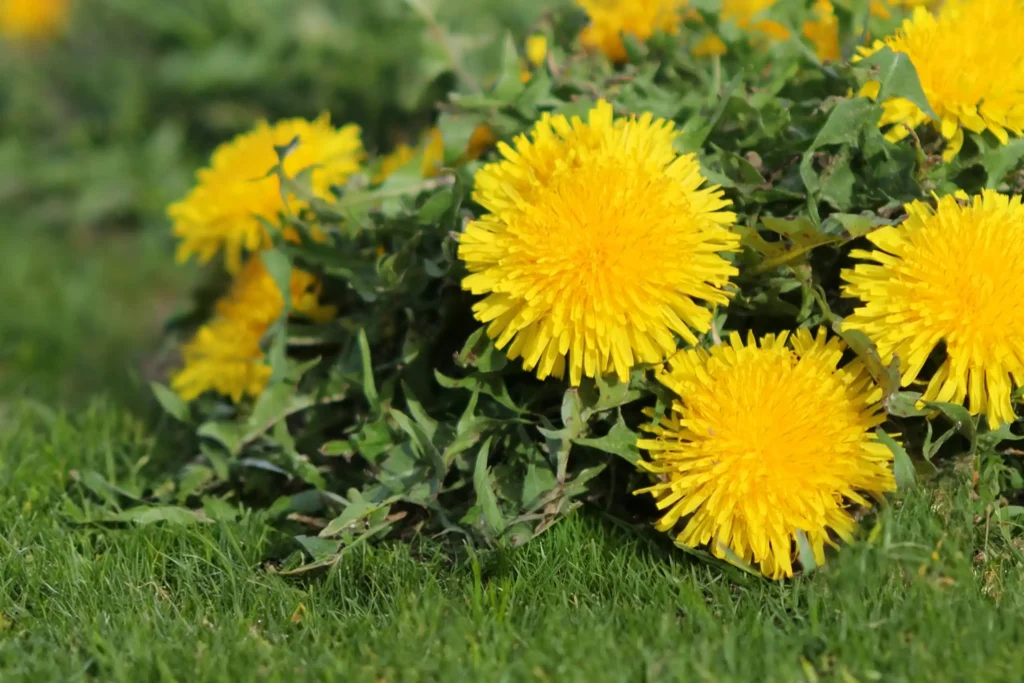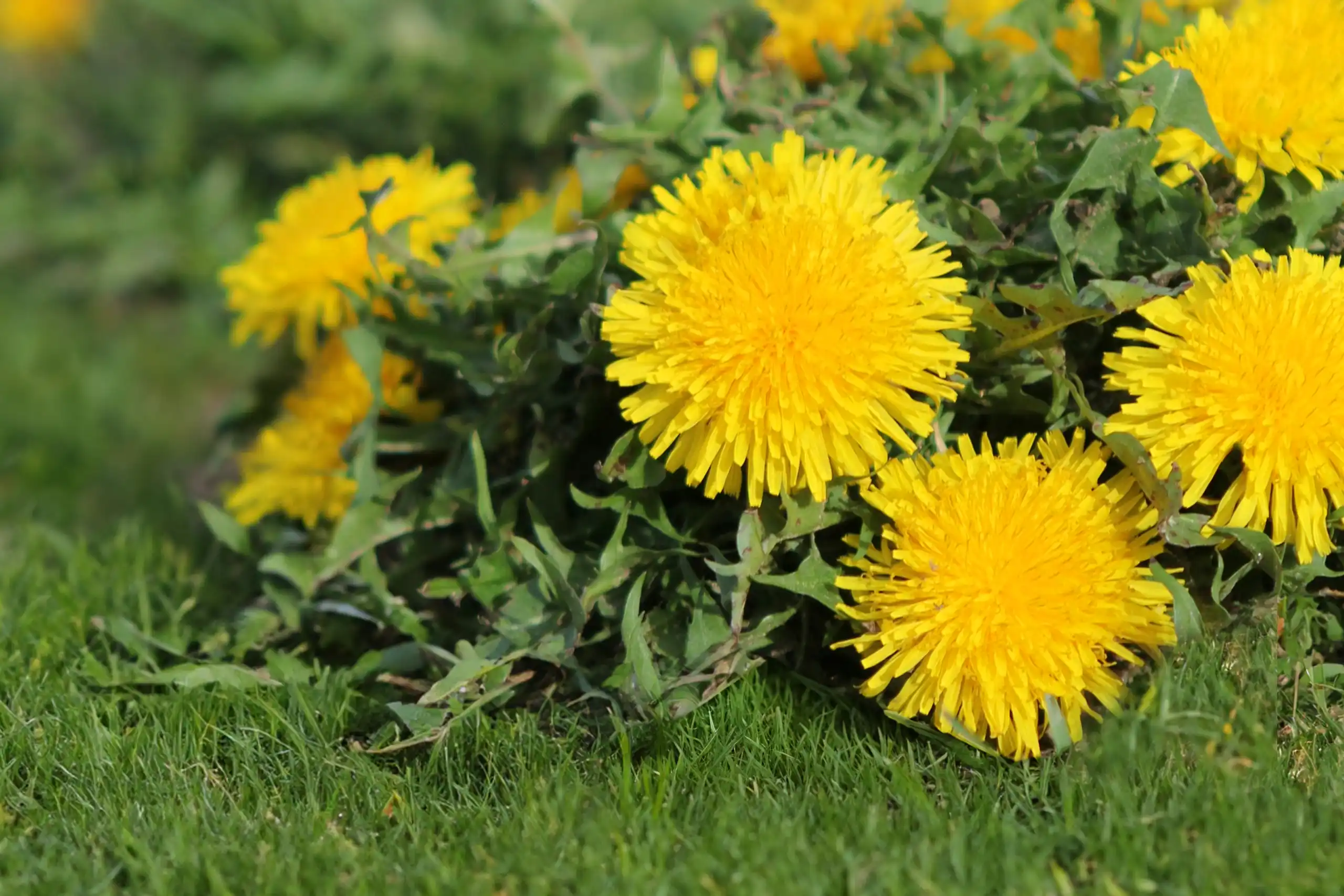After spending time, money, and energy creating a lush and healthy lawn, it can be disheartening when weeds start to appear.
Weeds are a constant source of frustration for many gardeners, as they not only ruin your lawn’s appearance but also steal the vital nutrients it needs to thrive.
However, these common lawn pests can be easily dealt with using the right approach.
In this guide, we’ll explore effective ways to kill weeds using both natural and chemical solutions, the most common types, and how you can prevent them from returning.

What are the most common weeds in the UK?
Whether you’re new to lawn care or a seasoned gardener, understanding the most common types of weeds and identifying them is essential for effective weed control.
Here are some of the most common types of weeds found in the UK:
Chickweed. Produces small white flowers and seeds very quickly.
Dandelions. Easily identifiable by their yellow heads and a fast-spreading weed.
Groundsel. Produce flowers that look like small dandelion heads and grow up to 22cm.
Fat Hen. Commonly found in vegetable gardens or compost heaps. Usually has broad green leaves and green-white flowers.
Creeping Buttercup. Also known for its bright yellow flowers, this weed prefers damp conditions and sprouts quickly.
Goosegrass. This rapid-growing weed can quickly take over your flower beds. You can usually identify this weed due to its stickiness.
It is important to check the type of weeds sprouting up in your garden, as some weed killers are formulated to treat specific types.
Once you have identified the weeds sprouting up in your garden, you can then go on to choose the best treatment for your lawn.
How do you get rid of weeds in grass using chemicals?
If you are looking for a quick and easy solution that doesn’t require a lot of labour, then chemical herbicides can be highly effective for treating weeds.
Chemical solutions can also be beneficial for those with larger gardens or those who are experiencing more persistent types of weeds.
Herbicides are split into two main types:
Pre-emergent. This type of herbicide is designed to be applied before weeds have sprouted. They essentially create a barrier in the soil to prevent seeds from successfully germinating.
Post-emergent. You would use this herbicide once the weeds have already sprouted. The chemicals within this herbicide can disrupt photosynthesis, interfere with growth hormones, and weaken the weed’s nutrient intake via its roots.
Our specially formulated Weed Wipeout treatment works to target and rid your lawn of stubborn weeds without disturbing your lawn and providing long-lasting results.
To apply herbicides safely, please follow the steps below:
- Read the label. It may seem obvious, but this is where you will find all the essential information and guidance on how to use the treatment correctly and safely.
- Wear protective gear. Herbicides can contain harmful chemicals, so always ensure you are wearing adequate protective clothing, such as gloves, goggles, and long-sleeve clothing.
- Check the timing. Chemical treatments tend to work best when weeds are actively growing, which is usually in late spring or early summer.
- Avoid extreme conditions. It goes without saying, but avoid extreme conditions like high heat or heavy rainfall, as this can cause herbicides to be less effective and may cause the chemicals to be carried to unintended areas.
- Clear your lawn. Remove any items on your lawn that could be potentially contaminated.
- Spray mindfully (for liquids). If you are using a sprayer to apply the herbicide, you need to be careful to avoid overspray. Try to use a sprayer with a fine nozzle to ensure that treatment lands directly on the weeds and not on your lawn.
- Spread evenly (for granular herbicides). For those using a granular pre-emergent herbicide, we recommend using a spreader for even application. You should always accurately measure the area you want to treat and mark it to avoid applying the product to unnecessary areas.
Clean your equipment. Always wash any equipment after carrying out this process to avoid contamination. - Dispose properly. Ensure you dispose of herbicides as per your local regulations and never pour any unused chemicals down the drain.
| Top Tip If you have planted a new lawn, you will need to wait six months for it to be fully established before treating any weeds that may have appeared. |
How long does weed killer take to kill weeds?
We understand that once you have applied weed killer to your lawn, you want it to work as soon as possible.
How long it takes can depend on the type of weed, where it is located, and what stage of growth it’s at.
Systematic weedkillers can start to take effect in a matter of hours. However, this does not mean the plant will die immediately, but more that the process is starting.
Generally, you should expect weed killers to eliminate weeds 7–14 days after treatment, although more stubborn varieties may take slightly longer.
How to kill weeds naturally?
It is possible to remove weeds from your lawn without the need for chemicals.
Natural methods are often preferred for those with pets and children, as well as those who only need to remove a few weeds.
Here are some of the most well-known methods:
Boiling water. This method is ideal for weeds that have sprouted on paths, driveways, or patios. Make sure no boiling water is poured on surrounding plants, as this can be highly damaging.
Vinegar. A higher concentration of vinegar can draw the moisture out of the weed, causing it to dry out and die. This can also be a handy solution for any paved or concrete areas, as weeds can grow in cracks, making them more difficult to remove manually.
Salt. Can be very effective at getting rid of weeds, as it also works by dehydrating them. Salt can kill other plants in your garden and can impact the pH of your soil, so be sure to only use it on paving and paths.
Manual weeding. Perhaps the most common and cheapest solution is to pull the weeds out by hand. This can easily be done when the soil is moist; however, this solution is more suited to those with smaller gardens.
Does washing up liquid kill weeds?
Yes, washing up liquid can kill weeds when it is combined with other ingredients, such as salt or vinegar.
It does this by helping the mixed solution stick to the weeds more effectively, so they can begin the dehydrating process.
Moreover, washing up liquid can also help the acidic ingredients penetrate the leaf pores, as opposed to the solution just sitting on top of the weed.
Is it better to pull weeds or spray?
When you are confronted with weeds in your garden, you may be wondering whether the most effective method would be to pull them out manually or spray them with a solution.
However, making this decision depends on a number of factors, such as:
- Your lawn size
- The type of weeds
- Soil and lawn health
- Climate and weather conditions
- Time and maintenance required
- Effectiveness
For instance, pulling weeds is an excellent solution for those with smaller lawns, as well as for targeting specific weeds without exposing your garden to chemicals.
However, this method does have its drawbacks, as it can be time-consuming and can leave the potential for regrowth if the weed’s roots have not been removed completely.
Spraying is often preferred, particularly by those with larger gardens, as it is quick, easy, and super effective for even the most stubborn weeds.
However, this method also comes with its disadvantages, as there is always the risk of harming surrounding plants due to overspray.
How do you prevent weeds from returning?
Preventing weeds from sprouting up on your lawn requires a proactive approach.
Removing existing weeds is a great first step, but to ensure weeds do not return, you need to be providing your lawn with consistent care.
Use the following tips to help keep weeds at bay and prevent them from returning:
Maintain mowing height. Keeping your grass at its optimal height can help keep your lawn dense and thick, allowing it to outcompete weeds for nutrients, air, and water
Use mulch as a blocker. Covering your soil with a layer of mulch creates a barrier that stops weed seeds from germinating effectively
Aerate your lawn. This process helps to relieve soil compaction, which creates an ideal environment for weed growth
Test soil health. Regularly test your soil and ensure its pH is balanced. Poor soil health can not only lead to weeds but also other pests like fungus.
Reseed bare patches. Ensure you regularly overseed areas that are bare or thinning, as these are ideal spots for weeds to establish.
Avoid overwatering. This can create moist conditions, which are preferred by weeds.
Fertilise regularly. Use our expertly blended Perfect Prep Lawn Fertiliser to promote healthy grass growth. A thicker and more nutrient-rich grass can effectively out-crowd weeds.
Monitor your lawn. Regularly check your lawn for any signs of weed growth or development so you can take action right away.
Ready to take control of your lawn?
Effectively ridding your lawn of weeds all starts by understanding the most effective methods and choosing the best products suited to your lawn’s needs.
Whether you prefer chemical solutions or more natural remedies, the key to protecting your lawn from weeds is consistency.
Start your journey to a better lawn today and take our quiz to find out the best products to get your turf back on track.
